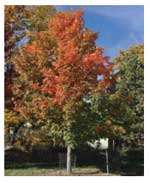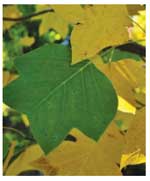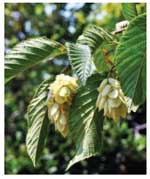 In addition to the usual factors for tree selection, such as cold hardiness, soil tolerance, water needs and mature size, species diversity should be a critical consideration. To create species diversity, plant no more than 10 percent of any single species, 20 percent of any genus and 30 percent of any family, especially in larger landscape settings. In addition to the usual factors for tree selection, such as cold hardiness, soil tolerance, water needs and mature size, species diversity should be a critical consideration. To create species diversity, plant no more than 10 percent of any single species, 20 percent of any genus and 30 percent of any family, especially in larger landscape settings.
Colorado State University continues its woody plant evaluation research, collecting data yearly. Consider the following eight woody plant species to add more tree diversity in your urban application.
Acer saccharum ssp. Caddo - Caddo Sugar Maple
This subspecies of sugar maple appears more tolerant to our alkaline soils with little to no chlorosis. Darker green leaves are more leathery, tearing less in the wind, and fall foliage is red to orange to yellow. It grows to about 30-35 feet in height and width. Numerous clones are available including ‘Autumn Splendor’ and ‘Flashfire’®. Tips & Tricks: This maple’s origin is Caddo County, Oklahoma making it more tolerant to our alkaline, higher pH soils. Zone 4-5, adapts to part shade, requires more moisture
 Liriodendron tulipitera ‘JFS-Oz’- Emerald City® Tuliptree Liriodendron tulipitera ‘JFS-Oz’- Emerald City® Tuliptree
Emerald City has an upright- oval growth habit with sturdy branching and strong open angles. It has glossy, dark green leaves that are tulip shaped and turn bright yellow in fall. The yellow-green flowers with an orange center appear after the leaves emerge. The tree grows to about 45 feet in height and 20 feet in width. Tips & Tricks: This plant can be used as a street or shade tree, or for screening. It may develop some chlorosis depending on pH of soil. Zone 5, full sun, requires more moisture
 Ostrya virginiana - American Hophornbeam Ostrya virginiana - American Hophornbeam
This handsome, pest resistant, smaller tree performs well in urban settings and is tolerant of alkaline soils and drought. Dark green leaves turn yellow in the fall. This is an understory plant that can tolerate sun. It grows 35-40 feet in height and 25 feet in width and it is somewhat slow to reestablish after transplanting. Tips & Tricks: Hop-like fruits and finely serrated hornbeamlike leaves give this adaptable tree its name. Zone 4, adapts to part shade, Xeric
See more top performers in the May-June 2018 issue of Colorado Green magazine.
Read more in this issue of Colorado Green NOW:
Social media: keep it short, make it visual
Denver green roof task force makes final recommendations
Landscape Career Pathways update [infographic]
OSHA outlines enforcement of silica standard
ALCC recently attended Facebook Community Boost Denver, a free conference designed to help small businesses use Facebook and Instagram more effectively. Over the next few months, Colorado Green NOW will feature some of the lessons learned at this event.
Think small
When creating content for social media, design it for the small screen and for people on-the-go.
The term “thumb-stopping” was used often throughout the event. A thumb-stopping post is one that cuts through the noise of a person’s social media feed and makes them stop scrolling to get a better look at a post. Visuals—photos or videos—are the best tools for creating thumb-stopping content for mobile users.
Why target mobile users?
90% of Facebook use is mobile. For Instagram, it is nearly 100%. Many users visit during short increments throughout their day, quickly scrolling through their feed. A striking photo or video is one of the best ways to grab their attention. Video gets a far better response from audiences than still photos.
Think fast
If you use video, the first three seconds of the video are critical. Your post is surrounded by a lot of other competing content. You need to pull the user to your content, and you need to do it quickly.
When people browse social media and ads, they notice elements in this order:
- Images
- Logo
- Copy (text)
Keep that in mind when creating posts. Grab their attention with an image or video, and keep the copy to a minimum. Remember that they are only visiting the app in short windows of time, so get to the point quickly.
But how I do create thumb-stopping video in addition to running my business?
Stay tuned to the next Colorado Green NOW for tips on free tools to help you create great content on a budget—or on no budget.
Read more in this issue of Colorado Green NOW:
Denver green roof task force makes final recommendations
Landscape Career Pathways update [infographic]
OSHA outlines enforcement of silica standard
Top performers from CSU offer more plant diversity
|


 In addition to the usual factors for tree selection, such as cold hardiness, soil tolerance, water needs and mature size, species diversity should be a critical consideration. To create species diversity, plant no more than 10 percent of any single species, 20 percent of any genus and 30 percent of any family, especially in larger landscape settings.
In addition to the usual factors for tree selection, such as cold hardiness, soil tolerance, water needs and mature size, species diversity should be a critical consideration. To create species diversity, plant no more than 10 percent of any single species, 20 percent of any genus and 30 percent of any family, especially in larger landscape settings. Liriodendron tulipitera ‘JFS-Oz’- Emerald City® Tuliptree
Liriodendron tulipitera ‘JFS-Oz’- Emerald City® Tuliptree Ostrya virginiana - American Hophornbeam
Ostrya virginiana - American Hophornbeam
